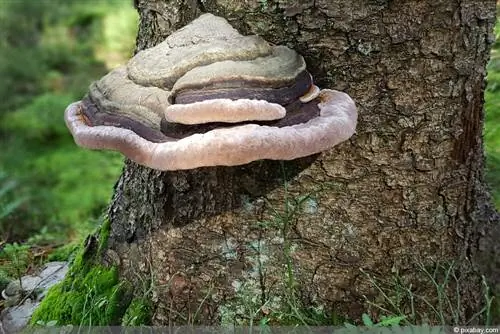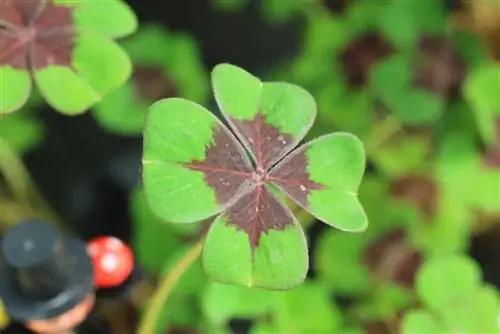- Author admin [email protected].
- Public 2023-12-17 03:39.
- Last modified 2025-06-01 06:48.
While some are looking for the four-leaf clover, hobby gardeners are annoyed by the avoidable lucky charms. Especially when it comes to the lawn, most people don't want it. Fortunately, removal is easier than you might think.
Cause of clover
Basically, clover is a good thing because it shows that the lawn is missing something. It mainly occurs when the soil lacks important nutrients. For example, there may be a lack of nitrogen, but clover can handle it well. The soil should also always be moist enough.
The simple journeyman: removing white clover
White clover can be easily recognized by its pink flowers. It is relatively easy to banish from the lawn by scarifying it. The turf is scratched so that the aeration of the soil can be improved. This should best happen between mid-April and mid-May. After that it should be mowed once or twice a week. This weakens the white clover and allows the lawn to regain the upper hand.
Prevent clover growth
- fertilize regularly (April, June and early to mid-October)
- no soil that is too firm or clayey
- water the lawn regularly in dry times
- Optimal pH value for the lawn: 6
- Buy a PH tester at the hardware store and test it regularly
- The lawn displaces the clover
- Scratch the turf in spring and autumn so that air gets into the ground
- Don't mow the lawn too often and deeply
The stubborn fellows: horn clover and wood sorrel
The horn clover and wood sorrel are a little more difficult. Horn trefoil has yellow flowers, wood sorrel has reddish-brown flowers. Both of them are not bothered by the mowing, they are actually happy about it because it gives them enough light to grow. Unfortunately, the only thing that helps here is the brutal method: the relevant areas have to be removed. The roots must definitely be removed as well, otherwise the clover will come back. The bare areas are then re-sown or can be planted with finished pieces of lawn. If the majority of the lawn is affected, the only solution is to completely replant the area.
A plastic tarp against the clover
As already mentioned, hornleaf and wood sorrel need light to thrive, which is why mowing is not suitable. That's why some hobby gardeners swear by a special method that may not look pretty at first, but is said to be very effective. A plastic tarp should be stretched over the lawn for several weeks. The clover dies because it lacks light. This also harms the grasses, but they are better able to recover from this withdrawal. It is best to leave the tarpaulin for 4 weeks. The advantage of this is that this method also eliminates other weeds in an environmentally friendly way.
Lawn weed-free - effective, but not environmentally friendly
If you want it to be easy, you can buy special products from specialist retailers. So-called plant protection products remove clover from the lawn because it absorbs the agent through the leaves, which results in very rapid cell growth as soon as it has reached the roots. This causes the nutrient supply to collapse and the clover dries out. The first successes usually become apparent after three weeks. Conversely, a chemical agent is not the best alternative if you want to act in an environmentally conscious manner. If you take this product, which does not attack monocotyledonous grasses, the lawn should not be mowed beforehand. The pesticide needs some “attack surface”. You should also follow the weather report, because it shouldn't rain in the following days if possible. If there was a longer dry period before the day of application, the lawn should be moistened well beforehand. Bare spots should then be nurtured with fertilizer. To find the right remedy, you should seek advice from a specialist.
Verticutting - an alternative?
Dethatching used to be a popular measure against clover and other weeds. However, this treatment not only killed the clover etc., but the lawn also suffered. It's much more helpful to grab a rake and use it to remove the clover. This is initially quite time-consuming and labor-intensive, but if you do it more often, you weaken the roots and thus prevent them from growing back.
Mowing the lawn and avoiding nitrogen deficiency
By the way, frequent lawn mowing is also very effective! But be careful: the cutting length should not be less than 3 - 5 centimeters, otherwise the blades of grass will not have enough leaf mass left to regenerate. Your lawn will thank you!
Too much clover in the garden is often a clear sign of a nitrogen deficiency or a signal that the lawn is not doing well for other reasons. Accordingly, it is simply too weak to defend itself against clover, dandelions, etc. Which means fertilizing would definitely be an interesting option. Best with a slow-release fertilizer.
Fertilize twice a year
So that its active ingredients are released evenly, it is recommended to fertilize once in April and once in July. The so-called combination products are currently particularly popular: These products are a product that combines lawn fertilizer and weed killer. This is not only an excellent solution against clover growth, but also helpful for moss and lichens in the lawn.
If possible, please avoid using too much poison and weed killer, as this will ultimately seep into the groundwater and also drive away the insects that are useful for the plants in your garden to thrive!






